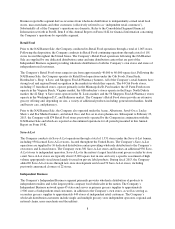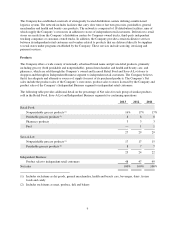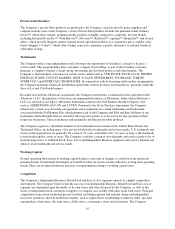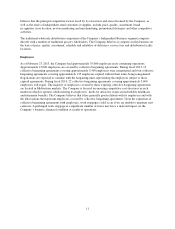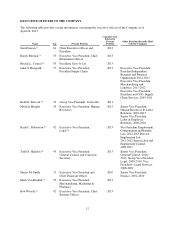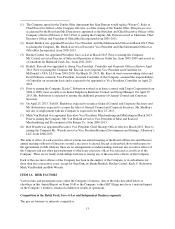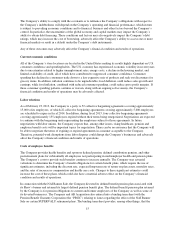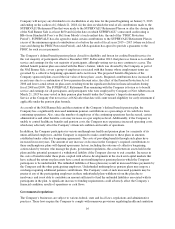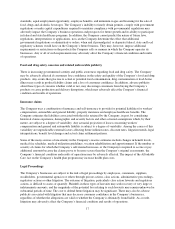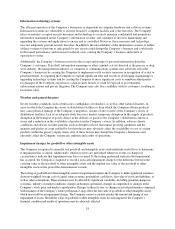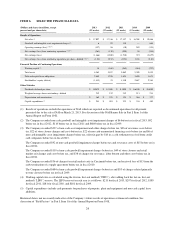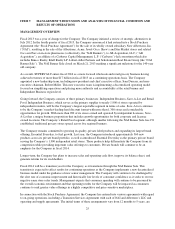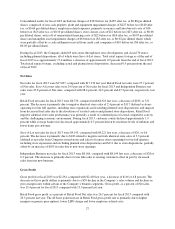Albertsons 2013 Annual Report Download - page 20
Download and view the complete annual report
Please find page 20 of the 2013 Albertsons annual report below. You can navigate through the pages in the report by either clicking on the pages listed below, or by using the keyword search tool below to find specific information within the annual report.Information technology systems
The efficient operation of the Company’s businesses is dependent on computer hardware and software systems.
Information systems are vulnerable to security breach by computer hackers and cyber terrorists. The Company
relies on industry accepted security measures and technology to securely maintain confidential and proprietary
information maintained on the Company’s information systems, and continues to invest in maintaining and
upgrading the systems and applications to ensure risk is controlled. However, these measures and technology
may not adequately prevent security breaches. In addition, the unavailability of the information systems or failure
of these systems to perform as anticipated for any reason could disrupt the Company’s business and could result
in decreased performance and increased overhead costs, causing the Company’s business and results of
operations to suffer.
Additionally, the Company’s businesses involve the receipt and storage of personal information about the
Company’s customers. Data theft, information espionage or other criminal activity directed at the grocery or drug
store industry, the transportation industry, or computer or communications systems may adversely affect the
Company’s businesses by causing the Company to implement costly security measures in recognition of actual or
potential threats, by requiring the Company to expend significant time and resources developing, maintaining or
upgrading technology systems and by causing the Company to incur significant costs to reimburse third parties
for damages. If the Company experiences a data security breach, it could be exposed to governmental
enforcement actions and private litigation. The Company may also lose credibility with its customers, resulting in
lost future sales.
Weather and natural disasters
Severe weather conditions such as hurricanes, earthquakes or tornadoes, as well as other natural disasters, in
areas in which the Company has stores or distribution facilities or from which the Company obtains products
may cause physical damage to the Company’s properties, closure of one or more of the Company’s stores or
distribution facilities, lack of an adequate work force in a market, temporary disruption in the supply of products,
disruption in the transport of goods, delays in the delivery of goods to the Company’s distribution centers or
stores and a reduction in the availability of products in the Company’s stores. In addition, adverse climate
conditions and adverse weather patterns, such as drought or flood, that impact growing conditions and the
quantity and quality of crops yielded by food producers may adversely affect the availability or cost of certain
products within the grocery supply chain. Any of these factors may disrupt the Company’s businesses and
adversely affect the Company’s financial condition and results of operations.
Impairment charges for goodwill or other intangible assets
The Company is required to annually test goodwill and intangible assets with indefinite useful lives to determine
if impairment has occurred. Additionally, interim reviews are performed whenever events or changes in
circumstances indicate that impairment may have occurred. If the testing performed indicates that impairment
has occurred, the Company is required to record a non-cash impairment charge for the difference between the
carrying value of the goodwill or other intangible assets and the implied fair value of the goodwill or other
intangible assets in the period the determination is made.
The testing of goodwill and other intangible assets for impairment requires the Company to make significant estimates
about its weighted average cost of capital, future revenue, profitability, cash flows, fair value of assets and liabilities, as
well as other assumptions. These estimates may be affected by significant variability, including potential changes in
economic, industry or market conditions, changes in business operations, changes in competition or changes in the
Company’s stock price and market capitalization. Changes in these factors, or changes in actual performance compared
with estimates of the Company’s future performance, may affect the fair value of goodwill or other intangible assets,
which may result in an impairment charge. The Company cannot accurately predict the amount and timing of any
impairment of assets. Should the value of goodwill or other intangible assets become impaired, the Company’s
financial condition and results of operations may be adversely affected.
18


